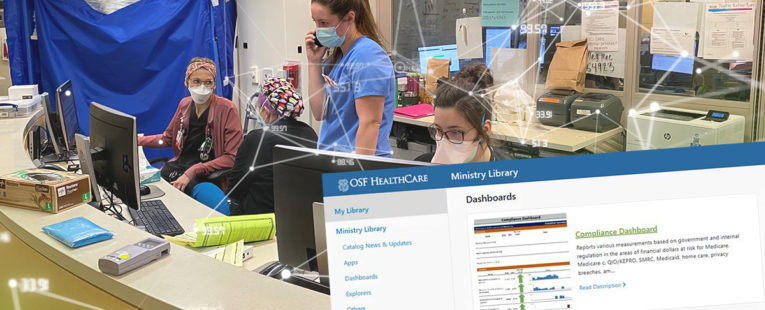Think about the steps you take to get an appointment with your primary care provider. You might self-schedule a routine check-up through OSF MyChart or call your office to set it up. On the day of, you arrive, check in, answer a few questions about insurance and COVID-19 and are soon led back to a room to take your vitals.
Before even talking with your provider, there were over a dozen data points described in the above paragraph. OSF leaders, with the help of our Healthcare Analytics division, bundle this data for monitoring trends and outliers in patient care.
Healthcare Analytics has created upwards of 80 tools, referred to as dashboards and explorers that cover nearly every aspect of patient care and institutional knowledge.
Dashboards and Explorers
Dashboards help users monitor progress toward OSF goals. Explorers allow Mission Partners to uncover valuable insights and opportunities through a flexible deep dive into the data.
These projects usually start with a business leader identifying a need. Let’s say a leader wants to reduce the average time it takes for you to be seen by your provider. Working with Healthcare Analytics, they would first need to define a measure, or a calculation, for that “appointment lead time” before bringing it into a tool.
Going back to our routine check-up example, we know the date you scheduled the appointment, and we know the day of the appointment. So, this metric would be the difference between your appointment date and scheduled date, averaged out across every appointment for every patient.
We then bring in other fields that let us make comparisons and ask questions about the data – is there a shorter lead time for self-scheduled appointments versus staff-scheduled?
That’s what these dashboards and explorers help us find out.
Enabling the use of data
With so many tools, data points, measures and fields maintained by different analysts and architects, it makes it challenging for Mission Partners to learn the nuances of each tool and get to the specific information they need. To put this in perspective, one of our Explorers includes up to 900 fields of data!
Another challenge we faced was that there was not an easy way for individuals to access these definitions and other tools that they didn’t already use. We typically relied on word of mouth to get these tools into the hands of Mission Partners who can benefit from them.
As a result, our team developed a central repository of our tools that is searchable and intuitive. This work is part of a broader vision to empower data-driven decision-making to optimize and transform health care for those we serve.
Analytics Catalog
The one-stop shop for Healthcare Analytics tools and metrics, called the Analytics Catalog, took about two-and-a-half years to develop and included help from the entire division.
With the newly-launched Catalog, Mission Partners can see which tools they have access to and routinely use, as well as other tools that may be relevant to them.
Along with detailed definitions, the Analytics Catalog includes descriptions of each tool and who supports it, as well as training videos Healthcare Analytics has developed for learning how to leverage certain tools.
All these features allow greater access, transparency, and support for interpreting data and making decisions to improve our patient care.
Last Updated: May 28, 2024
